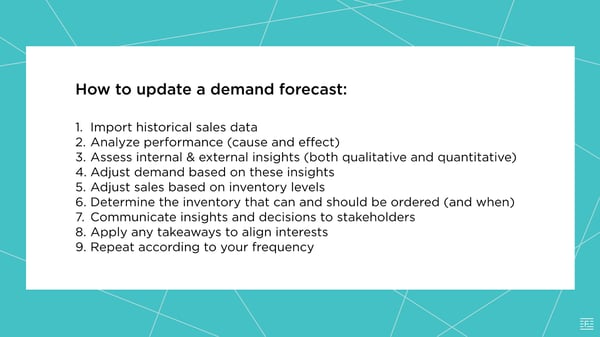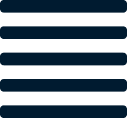Demand planning, also known as inventory or merchandise planning and forecasting, is the process of calculating consumer interest in order to understand the right quantity and types of goods to purchase, at the right time for the right place. Accurate planning can improve profitability and scale your business. In this guide you’ll learn:
- What the difference is between inventory management and inventory planning.
- What the difference is between demand planning and inventory forecasting.
- Why demand and inventory planning are important.
- How to get started with inventory forecasting.
What is the difference between inventory management and inventory planning?
Though often intertwined, there are differences between the tools and methods used for managing and planning inventory. While the act of planning inventory is a form of management, traditionally inventory management refers to the act of keeping track of goods in stock. Monitoring the location, quantity, dimensions, and weights of available inventory are all forms of inventory management.
Alternatively, inventory planning involves looking into the past, present, and future to know what products to order and when to order them by. Because inventory planning takes into account consumer demand, the process also informs the appropriate allocation of inventory between selling channels and locations. Inventory planning takes into account this demand, goods in stock, as well as goods on order to generate projected order quantities well into the future.
The goal of inventory management is to reduce inventory holding costs and facilitate fulfilment by communicating stock levels and locations. The goals of inventory planning go far beyond, informing future budgetary requirements, revenue projections, optimal product assortment, and much more.
Note, inventory control is another term for inventory management. Both refer to having control over and managing existing inventory.
What is the difference between demand planning and inventory forecasting?
The short answer - the differences are few and far between. It’s important to note that the terms forecasting and planning are often used interchangeably. As is the case with the words that precede them: sales, demand, inventory, and merchandise. There are 8 combinations of these words alone that might have you wondering, what’s the difference?
The difference between planning and forecasting
In the context of inventory, both planning and forecasting are supply chain management techniques used in timing, quantifying, and allocating products that will eventually be sold. Both functions account for internal and external factors that might impact demand. Such factors include:
External:
- Major shopping events
- Weather/seasons
- Macroeconomics
- Market and industry trends
- Competition
Internal:
- Historical performance
- Advertising/marketing initiatives
- Trends
- Seasonality
- New products
In analyzing these components, an inventory or demand planner predicts how much of a particular SKU to order at any given time and communicates this information to the rest of the business to ensure interests are aligned in supply chain, finance, and marketing. Beyond cross-functional alignment, having a prediction sets a bar for assessing performance and allows for continuous refinement as new information is received.
So is there a difference between planning and forecasting? Hardly. Planning can sometimes be seen as the act of thinking about and strategizing for the future in order to meet an objective goal whereas forecasting takes past insights into consideration along with judgement to inform a future prediction.
Depending on the size of the business, planning can be reserved for those in management as it is more strategic. However, strong demand planners possess the ability to do both planning and forecasting. Due to the degree of overlap, the remainder of this piece refers to these terms interchangeably.
Note, within an organization, planners may define plans, forecasts, and projections as referring to variations of the following:
- Original revenue goal
- New possible outcomes based on new information/data
- Expectation based on TAM or return on ad spend (ROAS)
- Expectation based on inventory spend
The difference between sales and demand
In a perfect world, these two terms would identify the same thing - the value of goods expected to be sold. However, due to one critical component, the two are not always equal. Demand reflects the customer or market appetite for a business or product. But sales reflect what is or could be actually sold. A key component separating the two is the amount of inventory actually available.
For this reason, true demand cannot always be quantified, whereas sales can. Sales reflect actual past and current performance whereas demand serves as an indicator of performance. Planning is typically projected at a demand level, and based on current and future available inventory, a sales forecast is created.
Sales = minimum(demand, inventory available to sell)
Demand will determine how much of what items need to be ordered. But sales will determine when you will actually need to order as they take into account what you will actually deplete.
Order quantity = period demand - inventory available to sell in period
The difference between inventory and merchandise
Another pair of similar words, inventory and merchandise often get used interchangeably as the difference between them is slim. Merchandise refers to finished products that are available for sale. Whereas the term inventory can include both finished and unfinished goods. Inventory can refer to components or raw materials. As an example, a yellow dress on a store hanger can be seen as a piece of merchandise whereas the buttons and zippers on it can be referred to as inventory used to make it.
Goods are typically accounted for as records of inventory, not records of merchandise. The two terms also differ as verbs as merchandise refers to the trade whereas inventory refers to the calculation of stock.
The difference between demand (sales) and inventory (merchandise)
We’ve covered the major differences between demand/sales and inventory/merchandise. But what’s the difference between these pairs of seemingly identical terms? In simple terms, demand and sales are measurements of satisfying the customer with what they want and what they don’t know they want. The tools used to fill this demand are inventory and merchandise. Trends are quantified on the demand level and qualified on a merchandise level.
Why are demand and inventory planning important?
Now that you understand the jargon, you must be wondering why planning is so important in the first place. Beyond the organization and structure imposed by this function, businesses can expect growth as a result of accurate planning. The key benefits of planning are:
- Accuracy in future revenue expectations
- Improvement in the customer shopping experience through meeting demand
- Reduction in overstock and understock which maximize profitability across channels and minimize holding costs
- Ability to make data informed decisions
- Alignment across business functions like sales and marketing
- Insights into market conditions and the ability to react to changing demand
- Benchmarks for performance
How do you get started with inventory forecasting?
Since we’re using the terms planning and forecasting interchangeably, it’s important to note that the process expands beyond the manipulation of data. A good practice is to start big and work your way down to the details. To get started with planning, you need to:
- Establish a process for your team. Naturally, the first step in planning is to have a plan. How meta. This process should include timing and some form for deliverable or calendar management. You’ll also want to determine a consistent course of actions for each step.
- Set goals for yourself and the business. Outcomes of planning include revenue and cost goals, but it’s important to also establish the metrics you and your team will be measured on.
- Invest in a system to automate and optimize your workload. Most new businesses may start off with managing this function through a variety of excel or google sheets. Though as anyone who has grown a business may tell you, this is not a system that scales well. It’s worth investing in a system early on in order to centralize your data and improve accuracy. The time savings will be well worth it and you can rest assured you’re not exposed to the high risk of human error that is associated with a lack of systems.
- Maintain your forecast frequently. Once you have a solid foundation, be sure to continuously collect and analyze new information regularly. This will be your basis in updating and tracking performance. The typical time frames of forecasting are long term (1-5 years out) and short term (monthly and quarterly). Having a system in place will facilitate forecasting in more granular daily time periods.
- Keep your cross-functional team informed and accountable. This step is so important that we mention it twice. Remember planners are both strategic and informed. But they are just one piece of the puzzle. Use the guidelines established to effectively communicate with the rest of the business and hold others accountable. Inventory planning is truly a team effort as it impacts the majority of business functions.

To plan or not to plan?
The answer is to always plan. Every dollar invested in inventory is money that is not spent elsewhere. With expectations of future financial return, inventory is something that needs to be managed well. Doing so can ensure you’re optimizing your sales potential and improving your profitability. A key component in brand success is understanding the importance of demand planning. The rest is in execution.
.png)

.png)









.png)



%20hover.png)
.png)
hover.png)







Let us know what you think about this post
Put your comment below.